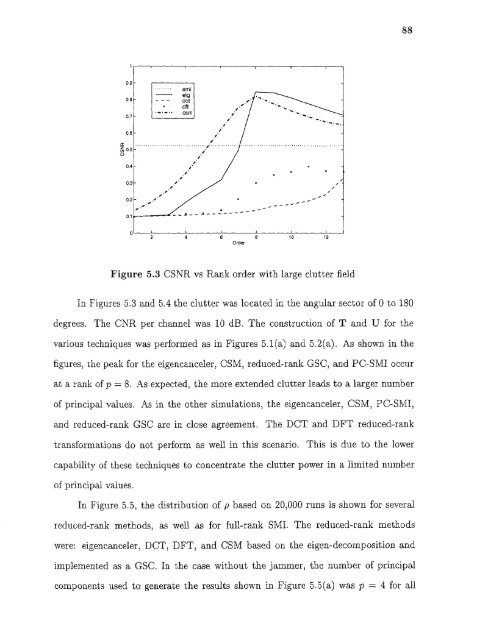Space/time/frequency methods in adaptive radar - New Jersey ...
Space/time/frequency methods in adaptive radar - New Jersey ...
Space/time/frequency methods in adaptive radar - New Jersey ...
Create successful ePaper yourself
Turn your PDF publications into a flip-book with our unique Google optimized e-Paper software.
88Figure 5.3 CSNR vs Rank order with large clutter fieldIn Figures 5.3 and 5.4 the clutter was located <strong>in</strong> the angular sector of 0 to 180degrees. The CNR per channel was 10 dB. The construction of P and U for thevarious techniques was performed as <strong>in</strong> Figures 5.1(a) and 5.2(a). As shown <strong>in</strong> thefigures, the peak for the eigencanceler, CSM, reduced-rank GSC, and PC-SMI occurat a rank of p = 8. As expected, the more extended clutter leads to a larger numberof pr<strong>in</strong>cipal values. As <strong>in</strong> the other simulations, the eigencanceler, CSM, PC-SMI,and reduced-rank GSC are <strong>in</strong> close agreement, The DCT and DFT reduced-ranktransformations do not perform as well <strong>in</strong> this scenario. This is due to the lowercapability of these techniques to concentrate the clutter power <strong>in</strong> a limited numberof pr<strong>in</strong>cipal values.In Figure 5.5, the distribution of p based on 20,000 runs is shown for severalreduced-rank <strong>methods</strong>, as well as for full-rank SMI. The reduced-rank <strong>methods</strong>were: eigencanceler, DCT, DFT, and CSM based on the eigen-decomposition andimplemented as a GSC. In the case without the jammer, the number of pr<strong>in</strong>cipalcomponents used to generate the results shown <strong>in</strong> Figure 5.5(a) was p 4 for all
















